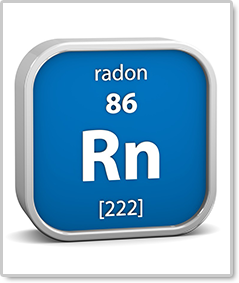Protecting Your Family from Deadly Radon Gas

The Environmental Protection Agency (EPA) recommends periodic radon testing, and more frequently if you have family members with asthma, allergies, respiratory illness, or a family history of cancer.
This article discusses:
-
Why should I be concerned about radon?
-
How can I tell if I have a problem?
-
How to lower the radon levels in your home?
Why Should I Be Concerned About Radon?
Radon is a cancer-causing radioactive gas which occurs naturally due to the breakdown of uranium in soil, and is usually found in igneous rock and soil. Radon gas is odorless and tasteless. The way radon gas gets into your home is that over time, the foundation of your home settles, and as it does hairline cracks form in your floor, and this allows the radon gas to seep into your home. In addition, sometimes building materials can also give off radon. And if your home uses well water, this can be a source of radon in your home.
Radon gas decays into radioactive particles that can get trapped in your lungs when you breathe. As they break down further, these particles release small bursts of energy. This can damage lung tissue and lead to lung cancer over the course of your lifetime. Not everyone exposed to elevated levels of radon will develop lung cancer. And the amount of time between exposure and the onset of the disease may be many years.
If the radon levels in your home are too high, this can create significant health risks for you and your family. The Surgeon General has warned that radon is the second leading cause of lung cancer in the United States today. And if any of your family members are smokers, high levels of radon will significantly increase their risks of getting cancer.
How Can I Tell If I Have a Problem?
According to the EPA, some regions of the country have higher radon levels than others, such as: Idaho, Montana, Wyoming, North Dakota, Iowa, large parts of Maine, New York, New Jersey, Pennsylvania, South Dakota, Indiana, Ohio, Illinois, Colorado, Nebraska, Kansas, some areas in Nevada. And here is a map from the EPA: http://www.epa.gov/radon/zonemap.html
But the only way to tell if you have radon levels in your home that are too high is by testing. Fortunately, this testing can be relatively easy and inexpensive to do.
The amount of radon in the air is measured in "picocuries per liter of air," or "pCi/L." The EPA recommends that you should take steps to reduce your radon levels if your home measures more than 4 pCi/L.
There are many kinds of low-cost "do-it-yourself" radon test kits you can get through the mail or in hardware stores and other retail outlets. Or you can hire a qualified tester to do the testing for you. For links and information, visit www.epa.gov/radon/radontest.html.
In general, there are three ways to test for radon: “short-term” testing; “long-term” testing; and “electronic monitoring”. All things considered, electronic monitoring can be the best solution for many homeowners.
SHORT-TERM TESTING:
Short-term radon tests give you a quick snapshot of what your radon levels are, but it is best to do several short-term tests over several periods, and then take the average of the readings. Depending on the test device that you use, short-term tests remain in your home for 2 to 90 days. Types of short-term test kits include "charcoal canisters," "alpha track," "electret ion chamber," "continuous monitors," and "charcoal liquid scintillation" detectors. A typical short-term test kit will cost about $15-30, and this will sometimes include the cost of the lab testing fee.
Testing is easy and should only take a few minutes of your time. Just follow the instructions that come with your test kit. Once you've finished the test, re-seal the package and send it to the lab specified on the package right away for analysis. You should receive your test results within a few weeks.
LONG-TERM TESTING:
Long-term tests remain in your home for more than 90 days. Types of long-term test kits include "alpha track" and "electret" detectors. A long-term test will give you a reading that is more likely to tell you your home's year-round average radon level than a short-term test. A typical long-term test kit will cost $50-90, and this will sometimes include the cost of the lab testing fee.
The average indoor radon level is estimated to be about 1.3 pCi/L, as compared to about 0.4 pCi/L which is normally found in the outside air. The U.S. Congress has set a long-term goal that indoor radon levels be no more than outdoor levels. While this goal is not yet technologically achievable in all cases, most homes today can be reduced to 2 pCi/L or below. Even if your test result is below 4 pCi/L, you may want to routinely test your home, because as mentioned above, as you home settles, it can allow fine cracks to allow radon to begin to seep into your home.
If you've tested the air in your home and found a radon problem, and your water comes from a well, you should have your water tested.
How To Lower the Levels of Radon in Your Home?
If you determine that you need to reduce the radon levels in your home, there are several ways to accomplish this, and the choice will depend on the type of foundation you have for your home (basement, slab on grade, or crawl space) and how severe your problem is.
Most solutions involve improved crack sealing and adding ventilating systems.
For a good description of the various types of radon reduction systems, you can see EPA's "Consumer's Guide to Radon Reduction”: http://www.epa.gov/radon/pubs/consguid.html
Because you can’t see or smell deadly radon gas, it is very easy to ignore a problem which could be lurking and harmful to your family. But fortunately, conducting routine tests are easy and inexpensive. We hope this article has helped you understand what radon is, why you should be concerned, and how to easily test to see if you have a problem.
Related Articles . . .
Why and How to Clean Your Smoke Detectors
To keep your smoke detectors operating properly, you should clean them at least every six months. This article explains why, and the easy steps you can take to clean your smoke detectors.
Properly Placing Your Carbon Monoxide Detectors
Just having CO detectors in your home is not enough . . . they need to be installed in the correct locations. This article explains where to, and where not to, install your CO detectors to be the most effective.
Preventing the 5 Most Fatal Home Accidents
Home accidents cause more deaths each year than any other reason except for motor vehicle accidents. This article and video discuss steps you can take around your home to prevent the 5 leading causes of home accident deaths.
7 Things That Can EXPLODE in Your Home!
If your attitude towards home maintenance is I don't want to know about it, unless it will keep my house from blowing up! . . . then you will love this article and video.
Choosing the Right Fire Extinguisher
You should definitely have a fire extinguisher in your kitchen, garage, and workshop. This article explains: the different types of fire extinguishers; how to select the right one; and how to properly use them.









